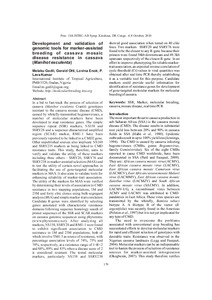| dc.contributor.author | Gedil, M. |
| dc.contributor.author | Otti, G. |
| dc.contributor.author | Enok, L. |
| dc.contributor.author | Kumar, L. |
| dc.date.accessioned | 2019-12-04T11:07:53Z |
| dc.date.available | 2019-12-04T11:07:53Z |
| dc.date.issued | 2012-02 |
| dc.identifier.citation | Gedil, M., Otti, G., Enok, L. & Kumar, L. (2012). Development and validation of genomic tools for marker-assisted breeding of cassava mosaic disease resistance in cassava (Manihot esculenta). In: Proceedings of the 11th triennial Symposium of the International Association of Hydrological Sciences held at Memling Hotel: Tropical roots and tuber crops and the challenges of globalization and climate changes, (pp. 179-186), Kinshasa, 4-8 October. Ibadan: ISTRC-AB. |
| dc.identifier.uri | https://hdl.handle.net/20.500.12478/1635 |
| dc.description.abstract | In a bid to fast-track the process of selection of cassava (Manihot esculenta Crantz) genotypes resistant to the cassava mosaic disease (CMD), caused by whitefly-transmitted begomoviruses, a number of molecular markers have been developed to map resistance genes. The simple sequence repeat (SSR) markers, NS158 and SSRY28 and a sequence-characterized amplified
region (SCAR) marker, RME-1 have been previously reported to be linked to a CMD2 gene. Other unpublished sources also implicate NS169 and SSRY235 markers as being linked to CMD resistance traits. This study, therefore, aims to verify and validate the utility of these markers including three others - SSRY20, SSRY76 and SSRY238 in marker-assisted selection (MAS) and to test the utility of certain novel approaches in facilitating the use of gene-targeted molecular markers in MAS. It also aims to validate tools for enhancing reliability of marker-trait association. The utility of the markers for MAS were verified
by determining their levels of association to CMD resistance in two mapping populations, 1M and 23M and forty elite clones using bulk-segregant analysis (BSA) and simple marker-trait correlation. Candidate R-genes were identified by selecting
genes annotated with characteristic resistance domains following sequence homology search of primer sequences of the SSR and SCAR markers on cassava genomic sequences using phytozome (www.phytozome.net). After analyzing all markers, NS158, SSRY28 and RME-1 were found to exhibit significant association to CMD resistance in 1M and 23M populations, both of which involve TME 3 as source of resistance, with percentage association levels of 74%, 75% and 70%, respectively, at a resistance range of 1=R<2 and 88%, 89% and 83% when a disease score of 2 is considered resistant. The tested molecular
markers, particularly NS158 and SSRY238 showed good association when tested on 40 elite lines. Two markers SSRY20 and SSRY76 were found to be the closest to any R-gene because their primers were found 58kb downstream and 49.3kb upstream respectively of the closest R-gene. In an effort to improve phenotyping for reliable markertrait association, an expected inverse correlation of cycle threshold (Ct) values to viral quantities was obtained after real time PCR thereby establishing it as a veritable tool for this purpose. Candidate markers could provide useful information for identification of resistance genes for development of gene-targeted molecular markers for molecular breeding of cassava. |
| dc.format.extent | 179-186 |
| dc.language.iso | en |
| dc.publisher | International Association of Hydrological Sciences |
| dc.subject | Cassava |
| dc.subject | Plant Diseases |
| dc.subject | Dna |
| dc.subject | Genomics |
| dc.subject | Ssr |
| dc.subject | Marker |
| dc.subject | Molecular Breeding |
| dc.subject | Mosaic Disease |
| dc.subject | Real Time Pcr |
| dc.title | Development and validation of genomic tools for marker-assisted breeding of cassava mosaic disease resistance in cassava (Manihot esculenta) |
| dc.type | Conference Proceedings |
| cg.contributor.crp | Roots, Tubers and Bananas |
| cg.contributor.affiliation | International Institute of Tropical Agriculture |
| cg.coverage.region | Africa |
| cg.coverage.region | West Africa |
| cg.coverage.country | Nigeria |
| cg.authorship.types | CGIAR single centre |
| cg.iitasubject | Cassava |
| cg.iitasubject | Plant Diseases |
| cg.iitasubject | Plant Genetic Resources |
| cg.howpublished | Formally Published |
| cg.publicationplace | Ibadan, Nigeria |
| cg.accessibilitystatus | Limited Access |
| local.dspaceid | 82572 |
| cg.targetaudience | Scientists |

